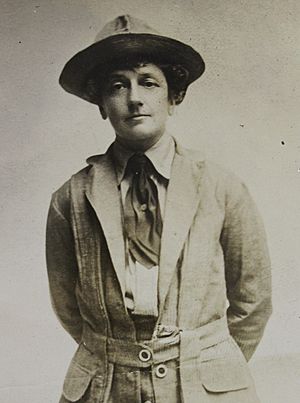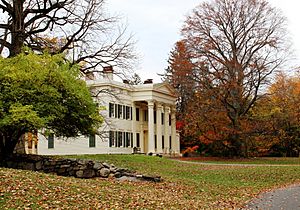Mary Rutherfurd Jay facts for kids
Quick facts for kids
Mary Rutherfurd Jay
|
|
|---|---|
 |
|
| Born |
Mary Rutherfurd Jay
August 16, 1872 |
| Died | October 4, 1953 (aged 81) |
| Nationality | American |
| Occupation | Landscape architect |
| Relatives | Pierre Jay, brother |
Mary Rutherfurd Jay (1872–1953) was an important American landscape architect. She helped design beautiful gardens and outdoor spaces. Mary also believed that women should learn about gardening and have careers in this field. She was a great, great granddaughter of John Jay, one of America's Founding Fathers. Mary grew up in Rye, New York, surrounded by the lovely gardens of her family's home, the Jay Estate. She learned a lot about design and plants by traveling with her mother and taking classes at places like the Massachusetts Institute of Technology (MIT).
Contents
Designing Amazing Gardens (1907–1929)
Mary Rutherfurd Jay started her career in 1907. Her first project was a "plaisance," or pleasure garden, for her sister's home in Greenwich, Connecticut. From this start, she designed over 50 projects for private homes. These homes were located all along the East Coast of the United States.
Her garden designs were very diverse. She used plants and ideas from many different cultures. Mary knew a lot about English, French, Dutch, Indian, Italian, Turkish, and Japanese garden styles. She learned about grand European and Asian garden elements. These included tree-lined paths, pergolas, and rock gardens. She then adapted these ideas for American gardens.
Jay called herself a "garden architect." She was inspired by André Le Nôtre, who designed the famous gardens at Versailles in France. Mary also shared her knowledge with others. She gave lectures in people's homes. She wrote articles for popular magazines like House Beautiful and House & Garden.
Mary designed gardens for many important people. These included famous architects and wealthy families. By 1926, she had an office in Manhattan. This was rare for women at the time. Her projects stretched from Palm Beach, Florida, to Manchester-by-the-Sea, Massachusetts. She worked with other well-known architects and designers.
Helping Others and Volunteering (1918–1919)
Mary was a strong supporter of women's education. She was an early member of the Women's Agricultural and Horticultural Association. This group helped women who wanted to work in her field. It later became the Woman's National Farm & Garden Association.
She also helped the Pennsylvania Horticulture School for Women. This school is now Temple University Ambler. Mary volunteered to help more people learn about the school. She also helped raise money for it.

After World War I ended, Mary used her garden skills to help people. She worked with the American Red Cross. She also joined the American Committee for Devastated France. This group was made of women volunteers. They were led by her friend Anne Morgan.
Mary's first job was to help farmers in France. She wanted to help them recover from the war's destruction. But because of fighting, she went to Versailles instead. There, she worked with wounded soldiers. She helped them by involving them in the "Garden Army Service." This showed her belief in the healing power of gardens.
Writer and Speaker
Most of Mary Jay's garden projects were finished by the late 1920s. After her brother and mother passed away, she focused more on writing.
In 1931, she wrote The Garden Handbook. This small book was for anyone who loved gardens. It had descriptions and photos of famous gardens. It also listed when different flowers and trees would bloom.
Mary was a very popular speaker. She gave talks to many garden clubs and societies. She used over 100 colorful slides to show beautiful gardens from around the world. She loved history and culture. Her talks highlighted what was lost in gardens during wartime. But she also showed how landscapes can recover and be restored through good design.
She also wrote a book about her family's history, The Jay Family (1935). It traced her family's roots back to France. It also showed how they connected to other early New York families.
Her Lasting Impact
Mary Rutherfurd Jay passed away in New York in 1953. Her collection of garden slides was given to her distant cousin, Beatrix Farrand. Farrand was also a landscape architect. Today, Mary's slides are kept at the University of California, Berkeley. They are available for people to study.
The family gardens that first inspired Mary are being restored. They are now open for the public to enjoy. The Jay Estate is a very important historical site. It is part of the Boston Post Road Historic District. It was named a National Historic Landmark in 1993. The Jay Estate is also part of the Hudson River Valley National Heritage Area. It was added to New York State's Path Through History in 2013.
An exhibit of Mary Jay's work was held at the Jay Estate from 2015 to 2016.
See also
 In Spanish: Mary Rutherfurd Jay para niños
In Spanish: Mary Rutherfurd Jay para niños
Images for kids


